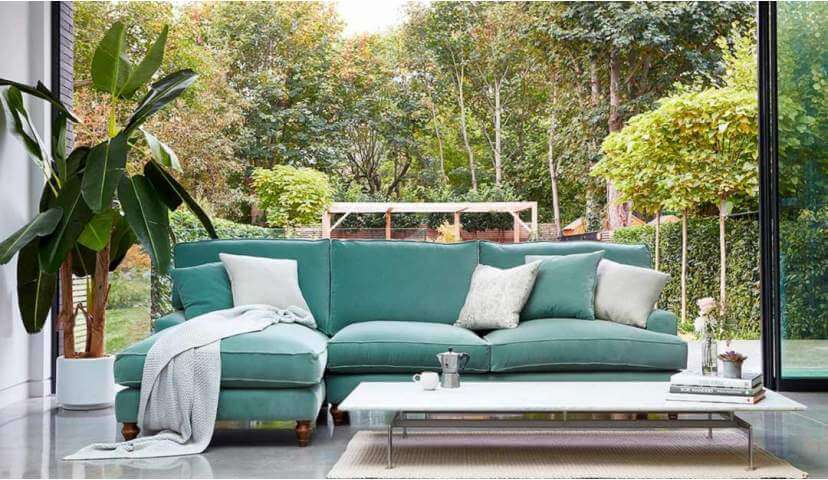Going Green: A Guide to Sustainable Interior Design
Sustainability has become a hot topic over the last few decades, with awareness ever more present when it comes to reusing and recycling what we can, when we can. But it’s not just about food waste and fast fashion, there’s so much more we can do including sustainable interior design.
Now more than ever retailers are incorporating information about how and where their furniture products are sourced, what their carbon footprint is and what their ambitions are moving forwards. This is a good thing, as it gives you the opportunity to shop with those who are really forging forward with their commitment to sustainability, like Darlings of Chelsea.
If you’re passionate about creating a sustainable environment at home, here are our thoughts on going green with sustainable interior design.

Image Credit https://www.forbes.com
What is Sustainable Interior Design?
First and foremost, it’s important to understand what sustainable interior design means. Ultimately, it focuses on reducing any negative impact on the environment through cutting waste, saving valuable resources, and protecting the planet both now and into the future, while at the same time improving/increasing the comfort and wellbeing of its users. This is not so much a trend as a movement, with real momentum behind it – with both businesses and members of the public now a lot more environmentally conscious than ever before. Sustainable interior design isn’t just about design in commercial environments, it’s a concept that translates across every style of interior.
The Key Principles of Sustainable Interior Design
There are several simple ways to incorporate sustainable interior design into your home. Here are the key principles:

1. It’s All in the Materials
The first thing to consider when it comes to an eco-friendly interior design is the materials you are planning to use. Materials that are extracted in an environmentally responsible manner and that are renewable can be used to create a green design interior that not only looks good, but it’s also less harmful to the environment, such as:
Bamboo
Reclaimed wood
Cork
and natural fibres
Once you’ve chosen your materials, make sure to check their labels to confirm their origin and if the information isn’t available, you can contact the retailer to check directly. If it has an FSC label, this means it has been certified by the Forest Stewardship Council. This non-profit organisation ensures forestry is practised in an environmentally responsible and socially beneficial way, i.e., ticking the necessary sustainable interior design materials boxes!
2. Built to Last
Trends come and go and there may be times when you want to refresh or upgrade your interiors. If you’re passionate about creating an eco-friendly interior, when making any changes, try and think about your interior design as a long-term investment – and choose quality furniture that has been built to last, reducing the need to replace products on a regular basis.
To add some character to your interior, as well as the purchasing of quality furniture, you could also look at upcycling some of your existing furniture – giving it a new lease of life rather than throwing it away. If that’s not going to work for you, rather than sending it to the tip, look at listing it on a second-hand site such as Pre-loved, Vinted or Gumtree, which will ensure your furniture is both recycled and reused.

3. Let There Be Light
Environmentally sustainable interior design encompasses not just your furniture but your entire room, including your source of natural light. The more sunlight you have streaming through your windows, the less electricity you’ll need, so think about how to maximise all your light streams.
The colour of your walls can also make a difference in how light your room feels. Whites, neutral and bright colours will all create a light, airy aesthetic, whereas richer deeper colours tend to create a cosier feel, where lamps and ceiling lights may have a bigger part to play.
Spend some time thinking about how to retain heat within your space. Insulating curtains or blinds can help prevent heat from escaping, while rugs can help a stone or wooden floor feel less cold and might help you to stave off putting the heating on that little bit longer.

How to Create Sustainable Interiors in Your Home
1. If you’re looking to tweak your interior rather than completely overhaul it, start with just one piece of furniture, which has been responsibly sourced and has sustainable accreditations, such as our Starling Chair, which features a teak frame and rattan back.
2.Look at your use of light and see if there are ways to reduce your use of artificial lighting – whether that’s through the colour on your walls or moving your furniture around to allow more light to stream into your room.
3.Think about incorporating some design into your aesthetic, connecting to the natural environment through house plants. Whether big or small, they can make a real impact on your space.
4.Always think about reducing, reusing, and recycling – if you’re replacing your sofa or sofa bed, don’t throw it away, look at passing it on to someone else. And if you like a piece of furniture but it’s looking a little tired, there are lots of ways to upcycle and completely change its appearance, giving it a new lease of life and enabling it to fit into your space that little bit longer.

Image Credit: https://hips.hearstapps.com/


